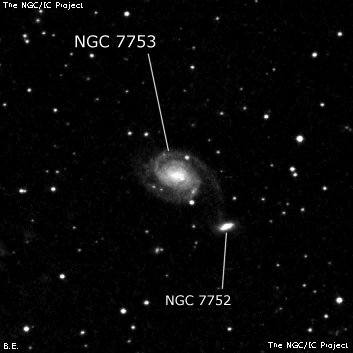
William Herschel discovered NGC 7753 = H II-213 = h2268 on 12 Sep 1784 (sweep 267) and logged "F; pL; lbM; a longish round." JH reported "pF; L; vgbM; 70"; r." Both Herschels missed the fainter companion.
300/350mm - 13.1" (9/22/84): fairly faint, moderately large, weak concentration. A mag 14 star is 0.9' SW of center. Forms a close pair with NGC 7752 2.0' SSW. This is a M51-type system (Arp 86) with NGC 7752 attached at the end of a spiral arm.
400/500mm - 18" (7/14/07): moderately bright, moderately large, slightly elongated, ~1.5'x1.3', broad concentration with a relatively large, brighter core that is also elongated. A mag 14 star is near the SW edge, less than 1' from center and a mag 15 star is on the NW side. Brighter of a close pair (Arp 86) with NGC 7752 2' SW.
900/1200mm - 48" (10/28/19): at 375x and 542x; very bright and large spiral, with the main body about 2' diameter (slightly elongated SW-NE), but the tidally stretched arm that wrapped towards NGC 7752 increased the length to at least 2.6'. Strongly concentrated with a bright core that increased to an intense nucleus. A faint star (mag 16.5?) was visible close southwest of the nucleus.
A spiral arm is connected to the east side of the core, though wasn't separated initially from the central region. It rotated sharply clockwise to the north, and was well defined as it passed directly through a mag 15 star on the north side of the halo. The arm faded as it separated away from the center and gradually curved south on the west side of the galaxy. The arm faded out just east of a mag 16.9 star [1.7' SW of center], before reaching companion NGC 7752, 2.0' SW of center.
The southern spiral arm emerged from the east or northeast side of the core. It curled tightly clockwise to the south and passed barely inside a mag 14.5 star. The arm was brightest in a strip near this star and then faded as it rotated to the east side of the galaxy.
Notes by Steve Gottlieb